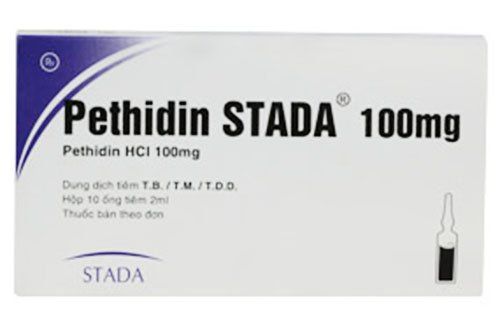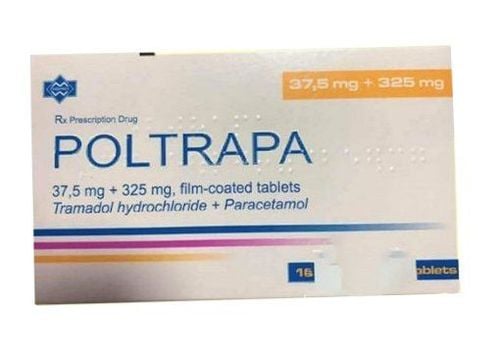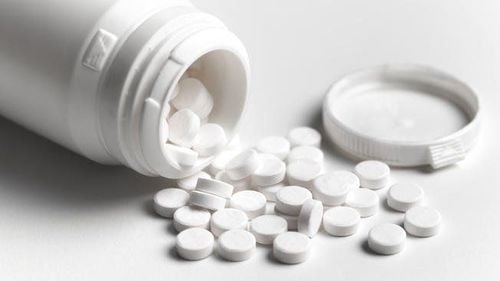This is an automatically translated article.
Osmadol has the active ingredient Tramadol, an Opioid pain reliever, indicated for the treatment of moderate to severe pain. So what are the uses, doses and precautions when using Osmadol?1. Uses of Osmadol
Osmadol contains the main active ingredient Tramadol, a synthetic opioid analgesic with central analgesic effect. The mechanism of action of Tramadol is to bind to the mu receptor of neurons and reduce the re-entry of Norepinephrine and Serotonin into cells. The analgesic effect appears after 1 hour of taking the drug and reaches its maximum effect after 2-3 hours. Unlike Morphine, Tramadol does not cause histamine release, does not affect heart rate and left ventricular function, and is less respiratory depression than Morphine when used at therapeutic doses.Osmadol is used to treat moderate to severe pain. The use of Osmadol is contraindicated in the following cases:
Patients with a history of hypersensitivity to Tramadol, any other component of the preparation or other opiate-like drugs. Acute poisoning with central nervous system depressants such as alcohol, tranquilizers, sleeping pills, central analgesics, psychotropic drugs. Patients with severe respiratory failure. Uncontrolled epilepsy. Concomitant treatment with or after discontinuation of monoamine oxidase inhibitor therapy for 15 days. Severe kidney or liver failure. Children under 15 years old and pregnant women.
2. Dosage and usage of Osmadol
Dosage:
The recommended dose of Osmadol is 50-100mg, once every 4-6 hours, maximum 400mg/day. The dose is adjusted depending on the severity of the pain and tolerability of the patient. For postoperative pain, the initial dose is 100mg, after 60 minutes, 50mg every 10-20 minutes to a total dose of 250mg. Then inject 50-100 mg, every 4-6 hours, the maximum dose is 600mg/day. Elderly patients (over 75 years of age): Use the lowest initial dose of the usual dose and increase the interval between doses, the maximum dose of Osmadol should not exceed 300mg/day. Renal failure: Patients with renal failure aged 17 years and older should be given a dose of 50-100mg, every 12 hours, not exceeding 200mg/day. Hepatic impairment: Patients with hepatic impairment 17 years of age and older should receive a dose of 50 mg every 12 hours. Usage:
Osmadol is administered by intramuscular injection, slow intravenous injection (for 2-3 minutes) or intravenous infusion.
3. Osmadol side effects
Patients using Osmadol may experience side effects including:
Common:
Body as a whole: Irritability; Cardiovascular: Lower blood pressure; Nervous system: Anxiety, confusion, restlessness, coordination disorder, nervous tension, sleep disturbance; Digestive system: Nausea, vomiting, abdominal pain, loss of appetite, bloating, constipation. Musculoskeletal system: Increased tone; Skin: Rash; Genitourinary system: Premenopausal symptoms, urinary incontinence, urinary retention Uncommon: Body as a whole: Allergies, anaphylaxis, tendency to addiction, weight loss. Cardiovascular: Postural hypotension, tachycardia, fainting. Nervous system: Abnormal gait, memory loss, cognitive disturbances, depression, difficulty concentrating, paresthesias, hallucinations, convulsions, tremors. Respiratory: Difficulty breathing. Skin: Stevens-Johnson syndrome, toxic epidermal necrolysis, urticaria, bullous. Sense organs: Taste disturbance. Urinary system - genitourinary: Difficulty urinating, menstrual disorders. Rare:
Cardiovascular: Electrocardiographic disturbances, hypertension, myocardial infarction, pulmonary edema, extrasystoles. Nervous system: Migraine headache, serotonin syndrome (fever, irritability, chills), voice disturbance. Gastrointestinal: Gastrointestinal bleeding, hepatitis, stomatitis. Laboratory indicators: Increased creatinine, increased liver enzymes, decreased hemoglobin, proteinuria. Other: Cataracts, deafness, tinnitus.
4. Notes when using Osmadol
Long-term treatment, if suddenly stopping the drug, can cause withdrawal syndrome with symptoms such as panic attacks, sweating, insomnia, nausea, tremors, diarrhea, hair growth. In some cases, hallucinations and paranoia may occur. Therefore, Osmadol should be used at the lowest effective dose, should not be used regularly and for a long time, and should not be stopped suddenly, but should be reduced gradually. At therapeutic doses Osmadol can cause convulsions, so extreme caution should be exercised in people with a history of epilepsy, in people with certain diseases at high risk of seizures, or in combination with MAO inhibitors, antiretrovirals, and anticonvulsants. tricyclic depression and neuroleptics. Osmadol does not cause the release of histamine but in some cases the first use of the drug can cause severe anaphylaxis. Patients with a history of anaphylaxis to Codeine or other opioids while taking Tramadol are at increased risk of anaphylaxis. Patients with a history of opioid dependence, if taking Osmadol, are at risk of becoming dependent again. Therefore, do not use Osmadol for this subject. Although Tramadol causes less respiratory depression than Morphine, when used in high doses or in combination with anesthetics, alcohol increases the risk of respiratory depression. Patients with manifestations of increased cranial pressure or head injury while taking Osmadol need careful mental status monitoring. Tramadol may cause drowsiness, drowsiness, and decreased alertness. Therefore, the patient should not take the drug while driving a vehicle or operating machinery. Pregnancy: Osmadol must be used in pregnant women with extreme caution and only when the potential benefit outweighs the risk of toxicity to the fetus. Pregnant women who use Osmadol for a long time are at risk of drug addiction and withdrawal syndrome for the baby after birth. Lactation: Because Tramadol passes into breast milk and the safety of the infant after administration has not been studied, Osmadol should not be used during breast-feeding. Osmadol should be stored in a sealed container, at a temperature of 15 - 25°C
5. Drug interactions
Drug interactions can change the potency and/or increase the side effects of the drug. Patients should tell the doctor, all the medicines they are using, including prescription and non-prescription drugs, dietary supplements for advice. Here are some drug interactions to watch out for when using Osmadol:
Carbamazepine increases the metabolism of Tramadol. If these two drugs are combined, the dose of Tramadol must be doubled. Quinidine has the ability to inhibit the enzyme CYP2D6, reducing metabolism and increasing the effect of Tramadol. Fluoxetin, Paroxetin reduce the metabolism of Tramadol. In contrast, Tramadol inhibits the reabsorption of Noradrenaline and Serotonin. Therefore, do not combine in the above drugs in treatment. Tramadol prolongs prothrombin time, therefore, when combined with Warfarin, it is necessary to periodically check prothrombin time. The article has provided an overview of the drug Osmadol. The above information is for reference only and cannot replace the guidance of your doctor/pharmacist. Therefore, to ensure safety when taking Osmadol, patients should consult with their doctor/pharmacist before use.













